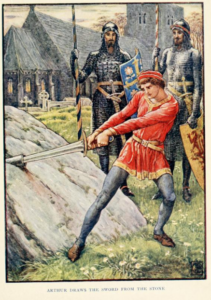Stevenson and Traditions of Satire
Linda Simonis
Published in Connotations Vol. 34 (2025)
Abstract
Stevenson is not usually considered a satirical writer. The following article seeks to explore this hitherto neglected aspect of Stevenson’s work. By drawing on two short stories which remained unpublished during his lifetime, “Diogenes in London” and “The Scientific Ape,” I will examine how Stevenson uses satirical techniques to shed critical light on current issues of contemporary nineteenth-century culture and science. Stevenson’s recourse to satire is closely linked with intertextuality: in adopting the satirical mode, the author often refers to earlier satiric texts and thereby inscribes himself into the tradition. The stories discussed here appear to be particularly indebted to Jonathan Swift’s writings from which Stevenson borrows both technical devices and literary motifs. In “Diogenes in London,” Stevenson explores the critical potential of an imaginary confrontation of the ancient philosopher with modern urban life: Diogenes serves as a critical observer and a satirical persona whose perspective unmasks the lack of concern for the individual prevalent in modern society. In a similar vein, in the fable “The Scientific Ape” the narrator adopts the view-point of a group of apes to intervene in the ongoing debates on the topical issue of vivisection. At the same time, the story ironically undermines and subverts the assumption of man’s superiority over animals propagated in the course of the vulgarisation of Darwinism.
[→ 171] In one of his short stories, Stevenson evokes a curious character rambling about the streets of contemporary London. It is the ancient philosopher Diogenes who, by a mysterious time shift, has been transferred to the modern age. The philosopher’s attempt to find his way through the maze of the modern metropole appears as an almost hopeless task—all the more so when he realizes that he has lost his most important piece of equipment: his lantern, which, apparently, has been stolen.
This is, in brief, the situation at the outset of “Diogenes in London,” an unfinished story by Stevenson, written in the early 1880s. It probably remained unpublished during the author’s lifetime and was printed for the first time by the prestigious Grabhorn Press, San Francisco in 1920. The following paper takes the figure of Diogenes as a starting point to explore Stevenson’s engagement with satire and his uses of satirical techniques in his writing. Although satire is not often associated with Stevenson’s works, it nonetheless presents a significant feature in some of his less well-known stories. Apart from “Diogenes in London,” we will look at a further text of short fiction by Stevenson, “The Scientific Ape,” which, although very different in tone and style, resembles the Diogenes story in so far as it also presents its subject matter in an ironic and satiric light. Before we examine the stories in more detail, it is useful to briefly recall the historical person of Diogenes and what he stands for.
Diogenes of Sinope—a Model of Satire
Diogenes of Sinope belonged to a group of ancient philosophers called the “cynics,” a name which is derived from the Greek word κύων (kýōn) meaning “dog.” The cynics saw themselves as doglike beings, leading a natural life, unconstrained by social conventions. In line with this programme, Diogenes adopted a deliberately simple and non-conformist lifestyle, sleeping and eating in the streets unconcerned about rules of decency or civility (see Desmond 77-78). [→ 172]
Apparently, the “philosophy” Diogenes proposes is not a philosophical doctrine or theory. Rather, it consists in a specific way of life, which, by continuous practice and performance, crystallizes into a social and philosophical habit. The cynic mentality represented by Diogenes thus constitutes a “tradition vécue” (Largier 4), a tradition of lived experience rather than a school of philosophical thought. Furthermore, by rejecting social norms and accepted values, the cynic philosopher not only promotes a project of philosophical life, but also takes a political standpoint: he pits himself against the city as much as against the established moral and social order. In this respect Diogenes appears as an emblematic figure. By his posture of non-compliance he stands out as a model of cultural and social critique, in short: as a prototype of the satirist. This aspect of satire foreshadowed in Diogenes’ character is what interests Stevenson about the cynic philosopher, and it is the point he further develops in his story.
It is worth noting that the lamp, which figures as a leitmotif in Stevenson’s story, is already associated with Diogenes in the ancient sources. The locus classicus for this emblem is an anecdote reported in the most important textual source on Diogenes’ life and philosophy, namely in Diogenes Laërtius’ Lives and Opinions of Eminent Philosophers (from the third century AD). According to this report, Diogenes used to carry a lamp (λύχνος) with him when wandering through the markets of Athens in broad daylight. He would hold up his lamp, peering into the faces of passers-by. When asked what he was doing, he would reply: “I am seeking for a human being.” (“λύχνον μεθ᾽ ἡμέραν ἅψας περιῄει λέγων ‘ἄνθρωπον ζητῶ’”; Laertius 42). In the transmission of the anecdote, we mostly find this statement translated as “I am seeking for an honest man.”
In the subsequent tradition, the lamp or lantern becomes the hallmark of the cynic philosopher and a recurring feature, particularly in paintings and visual representations.1 It is not by chance that, when making an appearance, for example, on the title page of an early modern printed book, Diogenes is usually carrying a lantern in his hand. In this [→ 173] posture he is accordingly also presented on the frontispiece of a collection of short allegorical and satirical texts from the early seventeenth century, composed by the pamphleteer Samuel Rowlands:

It is worth taking note of the lines inscribed above and below the image, two rhyming couplets which, taken together, summarize Diogenes’ project while, at the same time, they announce the motto of the booklet:
In Athens I seeke for honest men,
But I shall find them God knows when.
Ile search the City, where if I can see
One honest man, he shall goe with mee.
By alluding to the famous anecdote, these lines immediately call to mind the well-known image of the cynic philosopher and spotlight his critical attitude. Diogenes stands out as the speaker of the poem and simultaneously reveals himself as the protagonist of the booklet. The presentation of Diogenes, however, does not merely serve a historical or biographical interest. When calling up the city of Athens as the place of Diogenes’ activities, the poem also suggests a parallel between ancient Athens and (early) modern London. The portrayal of Diogenes [→ 174] thus invites the readers to transfer the figure of the cynic philosopher to the contemporary world and to imagine him strolling through the streets of London with his lantern. Although there is no evidence that Stevenson knew Rowlands’s booklet, the latter’s representation of Diogenes appears to foreshadow some features which will come to be crucial for Stevenson’s adaptation of the figure of Diogenes. Here, three aspects are worth noting: the leitmotif of the lantern as Diogenes’ key attribute, the satirical posture of the cynic philosopher, and the implicit evocation of the city of London as a fitting scene for Diogenes as well as his pursuit of critically scrutinizing the habits and social life of his contemporaries. Rowlands’s Diogenes Lanthorne thus provides a potential intertextual reference of or at least literary background to Stevenson’s story.
Whereas in Rowlands’s presentation the encounter of Diogenes with the world of the modern city is not directly expressed, but only hinted at and suggested, Stevenson’s story actually enacts this encounter; without offering any further explanation how this transposition may have come about, the story presents us with Diogenes roaming the streets of London.
The following considerations seek to investigate to what extent the satirical approach adumbrated in Diogenes’ attitude and critical engagements can be retraced in some of Stevenson’s writings. In setting about this inquiry, I will, however, not presuppose a fixed concept or definition of satire. As recent studies on satire have rightly pointed out (see, e.g., Knight 33, Stinson 15), satire is a “protean” form that includes manifold adaptations and variations. Moreover, satire transcends the limits of a single genre and seems to resist a clear-cut definition. Instead of drawing on generic terms, we can more appropriately describe satire as a “mode” or “tone” of writing (Greenberg 9-10) which can find expression in different genres and artistic forms. Of course, we can identify certain rhetorical and literary devices characteristic of the satiric mode such as irony, exaggeration, contrast, paradox, humour or ridicule, but even these elements vary according to the style and purpose [→ 175] of individual authors. Rather than invoking a general concept or theory, it therefore seems useful to take a closer look at the ways in which the satirical mode develops in Stevenson’s texts as well as at the specific effects it produces. Such a pragmatic approach further allows us to account for another distinctive feature of satire, i.e. the circumstance that satire always relates to a particular literary or cultural context on which its understanding and appreciation relies (see Greenberg 11). This observation points to a further aspect which appears to be crucial to the satiric mode: satire is intricately bound up with intertextuality. It frequently refers to something which is turned into the object of the satiric exposure. And this object of satire is, for the most part, not just a “thing” extracted from reality, but rather an element of previous communication or signification, a statement, an expression, a remark, a gesture, an image or text. In this sense, intertextuality can be taken to be intrinsic to satire to the extent that the latter requires a preceding text, discourse, aesthetic expression or performance to refer to and expose to criticism or ridicule. In addition, frequently, and not least in Stevenson, we can find in satire a second kind of intertextuality at work: the reference to previous instances, forms or genres of satiric communication by which the individual text inscribes itself into the satiric tradition. This type of borrowing, allusion or adaptation often serves to give more weight to the satiric intervention and to reinforce its critical effect. Such an employment of literary intertextuality, as we shall see, stands out prominently in Stevenson’s satiric writing where it functions as a means to underpin, and, at the same time, to enrich and give more nuance to the satiric depiction and argument.
A first and obvious case of a satirical mode in Stevenson’s writing can of course be found in the two Diogenes stories: as protagonist of a literary fiction, Diogenes seems to attract the satirical mode since he provides a persona whose unconventional perspective is predisposed to unfold a critical perception or observation of his environment. [→ 176]
Urban Encounters—Satire as Cultural Critique in “Diogenes in London”
In “Diogenes in London” Stevenson resumes the traditional image of the cynic philosopher but not without investing it with a noteworthy reaccentuation: Stevenson presents a Diogenes who has lost his lantern and is thus deprived of his most important instrument of critical observation.
Significantly, the story begins in medias res with Diogenes noticing the loss of his lantern: “My lantern!” he cried. “It is gone—after centuries, gone.” And, turning to his companion, a poet, Diogenes adds: “Damn it sir, […] the thing has been stolen!” (“Diogenes in London” 189).
The poet, who is referred to as Mr. Arnold (apparently an allusion to the famous poet Matthew Arnold), remarks that, by some curious coincidence, the theft has apparently occurred immediately opposite to Scotland Yard where they have just arrived. Mr. Arnold invites Diogenes to enter the police station to find his friend Vincent, who is a leading officer of the London police: “Follow me,” he continues, leading the way, “it is but a step; there you will find all the benefits of system” (189). The two visitors find Vincent in his office: “At the end of the apartment […] the great Criminal Investigator sat upon a dais, slightly raised, with his knees under a table” (189). The poet explains the philosopher’s concern:
“This gentleman’s lantern has been stolen,” said Mr. Arnold, […] “Plucked from his hand upon the street, immediately in front of Scotland Yard. The lantern is of small intrinsic value; but dear to the philosopher from old association.” (190)
But the police officer shows an unexpected reaction:
“Number 3,566,783,” wrote the investigator. “Ha, very, very gratifying.”
“What is gratifying?” inquired the sage.
“The percentage,” returned Vincent briefly.
“So,” said Diogenes.
“And now gentlemen, I do not see that I need detain you any longer. All has been done that man can do; […] and I have only to thank you for this interesting item.” (190)
[→ 177] Yet the philosopher will not be turned away so easily. He tries once more to put forward his request:
“And when may I hope to get my lantern?” inquired the sage.
“Your lantern?” repeated Vincent, laying down his pen. […]
“You have made a mistake sir,” he continued, with dignity. “This is the Criminal Investigation department.”
“Ah!” said Diogenes.
“Here, sir,” continued the chief of police, “we do not cope with crime: we investigate it.” (190)
The police officer thus reveals himself to be a scientist, a researcher and theorist who studies and analyses criminal phenomena but does not seek to solve them or to provide a remedy. Vincent stands in sharp contrast with Diogenes: whereas the cynic always aims to put his philosophy into practice, into lived experience, Vincent does not condescend to enter the lower depths of everyday life.
By juxtaposing the two characters, by presenting the police investigator against the backdrop of cynic philosophy, Stevenson develops a critique of modern science and the attitude of the modern scientist. Here, he adopts the traditional satire on the pedantic scholar (“Gelehrtensatire”) prominent in European Literature since the early modern period (see Košenina 7-12). As a notable example (which Stevenson may have had in mind) we can recall Jonathan Swift’s depiction of the inhabitants of the isle Laputa, whom Gulliver encounters on his third journey (see Swift 133-56). In Swift’s narrative, these scientists are presented as self-absorbed theoreticians who have no regard for any practical results of their own research. While building on the satirical tradition, Stevenson also adds a new aspect to his image of the scientific investigator which gives it a specifically modern twist. This aspect consists in the obsession with numbers that characterizes Vincent’s approach. Numbers are the core elements of the new science represented by the criminal investigator. The prominence of this mathematical dimension becomes even more evident over the course of the dialogue, for the investigator now discloses to his interlocutors his passion for a new scientific method which he presents as a French invention: [→ 178]
“We are altogether French in our ideas,” pursued Vincent, “entirely French: Français comme une pomme de terre. […]”
“Lucidity, lenity, clarity, classicality,” cried Mr. Arnold in a rapture. “French is irresistible. […]” (190)
The object of the interlocutors’ enthusiasm is, however, not French culture or literature but the new discipline of statistics whose remarkable rise in the nineteenth century was largely promoted by the works of French mathematicians, such as Adrien-Marie Legendre and Adolphe Quetelet. In the ensuing conversation, Vincent and Arnold concur in their fascination with the new discipline, while Diogenes functions as a detached observer:
“I can show you the French statistics, Arnold,” breathed Vincent, producing a book […].
“Ah!” exclaimed the poet, “let me gaze on them.” […]
“We are reading it in the original,” observed the Investigator, looking up for a second at Diogenes, with a certain radiancy of pride.
“We both speak it like natives,” added the poet with a nod. (190-91)
This dialogue points to a tendency in the development of nineteenth-century social sciences which social historians have referred to as “the reign of numbers” (Vormbusch 21). The techniques of empirical data collection and its mathematical analysis provided by statistics gave rise to new quantifying approaches in demography, medicine, and other domains of knowledge, and thereby held out the prospect of a mathematically precise method of investigation for the social sciences.
Yet, when reading the episode from the story, we do not feel invited to join in the celebration of statistics displayed by the poet and the investigator. On the contrary, the devices of exaggeration and amplification produce a satirical effect. The overstated enthusiasm of the two men gives an ironic note to the scene; the interlocutors’ behaviour is held up to ridicule.
Moreover, the silent presence of Diogenes establishes a counterpoint to the uncritical endorsement of what appears to be a scientific achievement. Indeed, Diogenes seems to have been almost forgotten by the scientific enthusiasts. This neglect points to the other side of the influence [→ 179] of statistics and calculative measurement in the human sciences: the quantitative perspective reduces the individual and their concerns to a “case” or to an “item” that, together with other items of the same type, enters the calculation process and is thus transformed into a number.
It is true that, in the story, Diogenes does not express any explicit criticism. But his presence as well as the leitmotif of the lamp serve as intertextual signs inviting us to recall the ἄνθρωπον ζητῶ which, according to the ancient testimonies, was the cynic philosopher’s personal motto and rule of conduct. This motto reminds us of the flipside of statistical science, the effacement of the individual.
In the second half of the story, the conversation between Arnold, Diogenes and Vincent is interrupted by the entrance of “Miss Braddon,” the fictional counterpart of Mary Elizabeth Braddon, a writer of popular sensation novels in the Victorian period. In the presentation of this encounter, the story apparently shifts the focus of attention to another socio-cultural domain, namely to the field of literature and education. Nonetheless, there is an underlying continuity between the two parts of the discussion as the issue of numeric quantification remains implicitly present in the second part, although with reference to a different social sphere—the literary market. Mary Elizabeth Braddon is known to have been one of the most popular and successful novelists of the Victorian period. Her popularity can be inferred from the circumstance that her novels were among the most widely stocked books in public libraries of the period.2 In Stevenson’s story, however, Miss Braddon is received rather coldly by Arnold, who blames her for what appears to him an inappropriate treatment of a novel by Walter Scott: “‘You have laid your hands on Scott, maʼam, in a spirit, I fear, far other than courtesy,’ said the poet” (191). This reproach refers to a notorious publication project which presented its first volumes around 1880: in this project, which prepared an abridged edition of Walter Scott’s novels,3 Mary Elizabeth Braddon had a decisive part. In particular, she was responsible for the edition of Scott’s Guy Mannering which appeared in an adapted and considerably abridged version. This editorial practice of adaptation is the object of debate between Arnold and Miss Braddon in [→ 180] the story. While Miss Braddon tries to justify her practice as a way of improving and updating the text (“I only Byronised him” 191), and thereby doing homage to its author (“if you knew how I adore him” 191), Arnold considers it as a destructive interference and an infringement of the author’s right to determine the form of his work and its reproduction. The interlocutors are not merely characterized by the arguments and positions that they articulate in their dialogue, but equally by the way they present and express themselves. Miss Braddon’s frivolous conversational tone betrays her superficial attitude and her lack of aesthetic sensitivity and intellectual depth. This insight, however, is not disclosed by a comment on the part of the narrator. Rather, in accord with the satiric convention, Miss Braddon is exposed to ridicule by her own language. Such a device of satiric unmasking is clearly at work in a casual remark in which Miss Braddon draws a parallel between the manner of dressing one’s hair and the process of writing or editing: “You see my curl papers?—each a complete condensed Waverley—in magenta, too, my favourite colour” (191). Here, the obvious incongruity of the metaphor, which reduces the literary text to the trivial register of cosmetics, creates a satiric effect and reveals the fundamental inadequacy of Miss Braddon’s approach.4 Furthermore, some of her remarks also reveal a financial interest motivating her novelistic production.5 Braddon, it seems, is all too willing to sacrifice literary quality for the benefit of economic profit.
Given the rather unfavourable image of Miss Braddon suggested by the story, we might suppose that the reader is then invited to embrace Arnold’s position. But this is not the case. For Arnold, in his turn, becomes subject to irony and critical scrutiny. This ironic perspective on Arnold is foregrounded when Miss Braddon, prompted by her realization of Diogenes’ Greek origins, broaches the theme of classicism: “Let us do something classical” (192). This suggestion is immediately taken up by Arnold with great enthusiasm:
“Classical!” cried the poet with sudden energy. “You bet your life! Vincent, touch the lyre, and we will tread a measure.” (192)
[→ 181] Subsequently we find Arnold and Miss Braddon performing a dance to a melody played by Vincent on a whistle:
and soon the apartment rang to that sweet melody; while the two famous authors, each bounding and tripping like a kid, followed the mazes of a gay impromptu dance.
“You now behold me happy,” said the poet, “Quite the Greek, you see.” (192)
The scene playfully and humorously brings to light Arnold’s attachment to classical Greek literature and culture. By presenting his classicist attitude in the form of a childlike dance, the story discloses the arbitrary nature and somewhat obsessive character of this predilection. Again, the episode alludes to a phenomenon of historical reality, the movement of classicism which crucially influenced the cultural and educational conceptions of nineteenth-century intellectuals. Matthew Arnold, as Stevenson’s contemporary readers would have known, was one of the most fervent adherents of classicism of his time. He admired and imitated classical Greek and Roman literature (see Shrimpton 472-75) and firmly defended the idea of the superiority and timeless exemplarity of classical models (see Vanheste 116-19). In his lectures On Translating Homer (1861-1862), for instance, Arnold promoted the idea of Homer’s unsurpassable perfection by referring to his work as “the most important poetical monument existing” (Arnold 1) while insisting that English translations of Homer, following the example of the German translator Johann Heinrich Voß, should be composed in “good English hexameters” (Arnold 76). By showing the Victorian “Sage” absorbed in the childlike activity of an “impromptu dance” the story sheds an ironic light on Arnold’s humanist ambitions suggesting a certain untimeliness of his classicist attitude and its potential failure to respond to the needs and challenges of contemporary society.
Finally, near the end of the story, Diogenes takes the chance to give voice to his sceptical quest for the human, which he presents in the form of a song:
I have been East, I have been West,
To earth’s remotest bound; [→ 182]
On every hand I sought the best,
The good I never found.
At last, from all the fools in flocks,
Methought I saw a man,
A-taking out the works of clocks,
Afar in the Soudan. (194)
Contrary to what is reported by the tradition, the protagonist of the song does find “a man,” but, ironically, the goal of his search is only reached in a place outside Europe, “afar in the Soudan.” By this ironic turn, the song humorously undercuts the pretended superiority of European culture along with the assumption that Western culture had a privileged access to the humanist legacy of classical antiquity.
The story apparently relies on a readership who know about Diogenes and his cynic philosophy; what is more, Stevenson even seems to expect his readers to be familiar with the anecdote of the lamp, perhaps even its literal wording, as reported in the Lives of the Philosophers. Intertextuality here serves to reinforce, if not to produce, the satirical impulse and critical effect of the narrative. Like his model in antiquity, Stevenson’s Diogenes takes the role of unmasking the illusions and false beliefs of his fellow-citizens.
Apes and Men: A Satirical Perspective on Modern Science
While “Diogenes in London” can be seen as a light-hearted, though serious mode of satiric narration, a darker and sharper form of satire can be observed in another story by Stevenson, “The Scientific Ape.” This fable was published posthumously in September 1895, in the August and September issues of Longman’s Magazine (see Parfect 388).
In “The Scientific Ape” the narrator adopts the viewpoint of an ape (or, more precisely: a group of apes) living on an island in the Pacific. One of them is caught by a vivisectionist and subjected to experiments in the laboratory before he manages to escape and return to his fellow apes with, as the narrator ironically adds, “only a trifling lesion of one foot” (“The Scientific Ape” 142). Inspired by what he has seen in the laboratory, the escaped ape becomes a fervent proponent of modern [→ 183] science, in particular vivisection. He appears to have endorsed the ideas of biological evolution and Darwinism, which he now propagates, although with a slight shift in perspective:
“Man is only a promoted ape,” said he, hanging his tail from a high branch.
“The geological record being incomplete, it is impossible to say how long he took to rise, and how long it might take us to follow in his steps. […] Man lost centuries over religion, morals, poetry and other fudge; it was centuries before he got properly to science, and only the other day that he began to vivisect. We shall go the other way about, and begin with vivisection.” (142)
Apparently, the ape’s speech is infused with allusions to the contemporary discussions on Darwin and his theory of biological evolution which Stevenson followed with great interest. Moreover, the passage refers to the controversy on vivisection which became an issue of public debate in Victorian England in the 1880s. Several leading scientists, among them Darwin himself, took part in this discussion (see Danta 51-55). In his account of the process of evolution, however, the scientifically informed ape inverts the conventional viewpoint: instead of regarding the human being as the most highly developed species of biological evolution, the cited passage reduces man to the status of a “promoted ape” while simultaneously attributing a higher evolutionary potential to the apes. Consequently, and not unlike his human homologues, the scientific ape considers vivisection as a key to scientific progress. To conclude his argument, he gives out the motto of the proposed scientific approach: “By vivisecting men, we find out how apes are made, and so we advance” (143).
But not all the apes are convinced by their fellow’s proposal. A vivid debate ensues, unfolding an exchange of arguments some of which (although with inverted premises) will have been familiar to the nineteenth-century reader:
“It seems rough on the men,” said the ape with one ear.
“Well, to begin with,” said the doctor, “they say that we don’t suffer and are what they call automata; so I have a perfect right to say the same of them.”
“That must be nonsense,” said the disputant; “and besides it’s self-destructive. If they are only automata, they can teach us nothing of ourselves; and if they can teach us anything of ourselves, by cocoanuts! they have to suffer.” [→ 184]
“I am much of your way of thinking,” said the doctor, “and indeed that argument is only fit for the monthly magazines. Say that they do suffer. Well, they suffer in the interest of a lower race, which requires help: there can be nothing fairer than that.” (143)
It is not by chance that the apes’ controversy centres on the questions of suffering and pain. These issues were strongly debated in the scientific and public discourses of the later nineteenth century, in particular in the context of discussions on vivisection (see Danta 51-55). Apart from its ethical and practical implications, the notion of the animals’ sensitivity to pain also has theoretical significance. The disposition to feel pain marks a shared property of humans and animals and thereby questions the common assumption of a clear-cut divide between human and non-human living beings (see Danta 60). But as the doctor ape’s reasoning shows, the argument of suffering can be turned around so that—instead of providing a common ground and uniting humans and apes in a community of living beings—it reinforces the division.
Finally, then, the doctor ape prevails, and the apes decide to begin their experiments by vivisecting the scientist’s baby. They manage to kidnap the baby and take it with them to the trees. But the vivisection experiment is interrupted by one of the apes who changes his mind:
“But I wish it would not cry,” said the ape with the one ear,
“it looks so horribly like a monkey!”
“This is childish,” said the doctor. “Give me the razor.”
But at this the ape with one ear lost heart, spat at the doctor, and fled
with the baby into the next tree top. (144)
The anti-vivisectionist position defended by the ape with one ear is then supported by the chief ape who intervenes to resolve the situation:
“What is all this about?” cried the chief. […]
“Can apes descend to such barbarity? Take back that baby where it came from.” (144)
But what seems to be a happy ending, a reconciliation of the species, again turns around and takes an ironic twist: [→ 185]
The vivisectionist (who was an estimable family man) was overjoyed, and in the lightness of his heart, began three more experiments in his laboratory before the day was done. (145)
Once more, this passage flips around the conventional assumptions about human beings and animals: while the apes prove to be sensitive and humane in showing compassion for the human baby, the human scientist, by contrast, remains unmoved and continues his vivisectionist project to its brutal conclusion. Or, to put it in more abstract terms: the apes acknowledge their biological affinity and commonality with human beings, whereas the human scientist apparently disavows or ignores his affiliation with the Primate (and, by implication, animal) world.
Significantly, the story presents itself in a deliberately non-realistic mode: apes, as we know, cannot speak nor do they practice vivisection. Besides, the postures and behaviour of the apes in the story are exaggerated and overdrawn. Taken together, these features clearly signal to the reader that the story presents a fictional scenario, a thought experiment, which is nonetheless able to relate to and comment on events and occurrences of the social world. Viewed from another angle, these elements are, of course, exactly the features that point out the irony and invite us to read the story as a satirical text.
Notwithstanding its overt simplicity, the literary technique of the fable is subtle: by reversing the roles of vivisectionist and the object of vivisection, of scientist and ape, the fable produces a decisive shift in perspective. The exchange of roles moreover invites an analogy and comparison between human beings and apes. Both aspects, the playful shifting of perspectives as well as the human-animal comparison are typical devices of satire. We might think, for example, of Gulliver’s Travels again, where the protagonist first encounters the Lilliputians, while, in the next episode, he finds himself in a land of giants. Similarly, Gulliver’s Travels also offers a model for the human-animal comparison suggested by the fable of the “Scientific Ape.” Here we can evoke the example of the Houyhnhnms, the horse-shaped speaking animals Gulliver meets in the final part of his voyages. For the satirist, the human- [→ 186] animal relation provides a means to inquire into what it means to be human and to expose the shortcomings and failures of human beings. In addition, a further parallel to Swift’s satirical writings can be observed: the vivisection of monkeys or humans in Stevenson’s fable recalls the idea of slaughtering and eating human babies satirically suggested in Swift’s A Modest Proposal. In both texts the cruelty of the proposed procedure is intensified by making an innocent baby its object and victim.
In a similar vein, Stevenson uses the human-animal relation to critically examine the human species, in particular in the shape of the modern scientist, and to cast doubt on man’s assumed superiority over other living beings. The ironic point of this juxtaposition is, of course, that, paradoxically, the seemingly inferior monkeys prove to be more humane than their human counterpart, the scientist.
In the two stories discussed above we find two different kinds of intertextuality at work in Stevenson’s satirical writing. While “Diogenes in London” mainly relies on references and allusions to literary texts (and their authors), “The Scientific Ape” draws primarily on non-literary scientific and wider public discourses whose arguments are taken up and reshaped in the discussions among the apes. In both cases, the satiric mode enables the texts to intervene in a public field of ongoing discourse and to recast the debate by their critical observations and ironic remarks. But despite the interventive quality of their satirical mode, Stevenson’s stories do not become completely absorbed in the discourses they comment upon, nor can they be reduced to a single unequivocal message.6 While using the mode of irony as a way of entering the discussions of their time, they also keep apart from them creating an aesthetic distance by their playfulness and humour. Intertextuality offers not least a means to maintain this distance.
Works Cited
Arnold, Matthew. On Translating Homer: Three Lectures Given at Oxford. London: Longman, 1861.
Danta, Chris. “The Metaphysical Cut: Darwin and Stevenson on Vivisection.” Victorian Review 36.2 (2010): 51-65.
Desmond, William. Cynics. London: Routledge, 2014.
Greenberg, Jonathan Daniel, ed. The Cambridge Introduction to Satire. Cambridge: CUP, 2019.
Knight, Charles A. The Literature of Satire. Cambridge: CUP, 2004.
Košenina, Alexander. Der gelehrte Narr: Gelehrtensatire seit der Aufklärung. Göttingen: Wallstein, 2003.
Laertius, Diogenes. “Diogenes of Sinope.” Lives of Eminent Philosophers. Ed. R. D. Hicks. Loeb Classical Library. Vol. 2: Book VI. Cambridge, MA: Harvard UP, 1972. 22-83.
Largier, Niklaus. Diogenes der Kyniker: Exempel, Erzählung, Geschichte in Mittelalter und Früher Neuzeit. Tübingen: Niemeyer, 1997.
“Literary Iconoclasts: The ‘Boiling Down’ of Great Novelists.” The St. James‘s Magazine and United Empire Review 41.4 (1881): 393-97.
Parfect, Ralph. “Robert Louis Stevenson’s ‘The Clockmaker’ and ‘The Scientific Ape’: Two Unpublished Fables.” English Literature in Transition 1880-1920 48.4 (2005): 387-400.
Rose, Jonathan. “Education, Literacy and the Victorian Reader.” A Companion to the Victorian Novel. Ed. Patrick Brantlinger and William Thesing. London: Blackwell, 2002. 31-47.
Rowlands, Samuel. Diogenes Lanthorne. London: Thomas Pavier, 1608. https://archive.org/details/bim_early-english-books-1475-1640_diogenes-lanthorne-_rowlands-samuel_1608.
Shrimpton, Nicholas. “Matthew Arnold.” The Oxford History of Classical Reception in English Literature. Vol. 4: 1790-1880. Ed. Norman Vance and Jennifer Wallace. Oxford: OUP, 2020. 471-94.
Stevenson, Robert Louis. “Diogenes in London.” The Strange Case of Dr. Jekyll & Mr. Hyde. Fables. Other Stories & Fragments. Ed. and Preface Lloyd Osbourne. London: Heinemann, 1924. 187-95.
Stevenson, Robert Louis. “The Scientific Ape.” Aesop in the Fog. Fables by Robert Louis Stevenson. Commentaries by Robert-Louis Abrahamson. Oundle: Lamplight P, 2022. 142-45.
Stinson, Emmett. Satirizing Modernism: Aesthetic Autonomy, Romanticism, and the Avant-Garde. New York: Bloomsbury, 2017.
Swift, Jonathan. Gulliver’s Travels. 1726. Ed. Albert J. Rivero. New York: Norton, 2002.
Vanheste, Jeroen. Guardians of the Humanist Legacy: The Classicism of T. S. Eliot’s Criterion Network and Its Relevance to Our Postmodern World. Leiden: Brill, 2007.
Vormbusch, Uwe. Die Herrschaft der Zahlen. Zur Kalkulation des Sozialen in der kapitalistischen Moderne. Frankfurt: Campus, 2012.
































 Ring out, wild bells, to the wild sky,
Ring out, wild bells, to the wild sky,